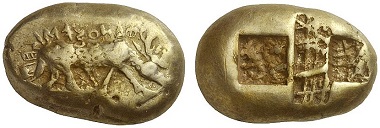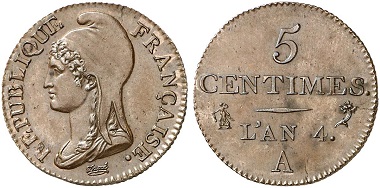Why did states start to mint their own coins? And why does the control of the monetary system belong to the most important governmental tasks? Here you will find an insight how this happened.
One of the first coins of humanity features the name ‘Phanes’ as its creator. Who this Phanes was exactly – a ruler, merchant, leader of mercenaries, or a priest – nobody knows. From Lanz auction 158 (2014), 252.
Private interest groups “invent” the coin
At some time in the second half of the 7th century BC, the minting of coins started. Who was responsible is still a matter of scholarly debate. In all probability, it was not any government. It is more plausible that coins were used either by mercenary leaders to pay their soldiers or by temples to personalise votive gifts.
The Parthenon on Athens’s acropolis was not only built with public money – it served also as treasure vault where the community’s money was stored. Photo: Wladyslaw Sojka / CC BY-SA 3.0
The state as the holder of the monopoly over money
Less than 100 years later, minting was in the hands of the state. Governments primarily minted coins to pay for infrastructure, such as temples, a fleet or – particularly important – a standing army. Therefore the control of the mints became a state monopoly: Whoever struck the money for the soldiers was the one who controlled the military. Rome and its coins turned into a model that was to survive the demise of the Roman Empire for centuries to come: powerful states controlled their coinage.
Every numismatist knows the story of the Tipper and See-Saw Time, when the governmental need for money was paid by the Joe Citizen who had no choice but to accept the poor money of cash-strapped rulers.
Public-private partnerships in the Middle Ages
In the Middle Ages, only a very few rulers were truly powerful. Accordingly, minting was mainly done through private-public partnerships. These partnerships proved a good business, both for the entrepreneur and for the state: The minting authority was guaranteed a seigniorage whereas the entrepreneur took care of his profit himself.
The bill had to be paid by the people. They were given change that was cheap to manufacture and contained only a small amount of silver. And this change always had to be exchanged at a significant premium. Gold or silver money of stable value was only available at considerable extra cost.
This, of course, weakened local economies. Those affected responded with destructive revolts at regular intervals. One of the main characteristics of a strong government, therefore, was to seize control of the coinage, in the best interests of the community, to make for good money.
One of the great achievements of the French Revolution was the introduction of a monetary system that did not disadvantage the user of small change: for twenty 5 centimes pieces made of copper he got a franc. During the Ancien Regime, a high fee had to be paid when exchanging small change for silver or gold coins. From Künker auction 263 (2015), 1720.
National money: a question of justice
The French Revolution introduced the decimal system. This was revolutionary – perhaps just as revolutionary as the Declaration of the Rights of Man and of the Citizen. It put an end to a split system consisting of money for the rich that was of stable value and inflationary money for the poor. The underlying idea was to use a functional currency to boost the nation’s economy. With the French Revolution, this idea spread throughout the whole of Europe and from Europe to overseas.
From then on, a coinage of one’s own meant independence. Until then, the colonies had been supplied with money by their motherland whereas independent nations founded and operated their own mints. The mints became a source of national pride. In this spirit, the first President of the United States, George Washington, immediately initiated the construction of a national mint. To the citizens, the images of the joint currency illustrated the values on which their identity was based.
Incidentally, something similar happened in the 1990s. Back then, the dissolution of the Soviet Union led to the foundation of national mints.
The cost factor
In recent decades, national identities have taken a back seat to economic interests, in the same way as the coin has lost its function as a mass medium. The mints have reflected this development insofar as the cost factor has now become the crucial factor in the debate. Therefore a question imposes itself: Does the financial effort it costs to dispose of an own national mint make any sense? Shall we return to the medieval and early modern practise to produce coins in private-public partnership?
This article was first published in Mint News Quarterly 03 / 2016. Mint News Quarterly is issued by Currency News in association with Monea. Editor is Ursula Kampmann.









